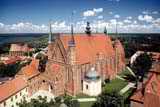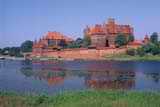THE SECOND WORLD WAR MEMORIALS IN POLAND

On September One, 1939, the German assault on the Polish garrison in Gdansk propelled the World into war. By the end of World War Two around twenty per cent of Polish citizens had been killed and much of the fabric of the country had been devastated. This two-week study tour visits locations and attempts to assist understanding of the terrible events of half a century ago.
ITINERARY

DAY ONE
Arrival in Warsaw. The tour will begin with a guided walk around the City, almost totally destroyed in 1944, but with the old core now faithfully rebuilt as it used to look.
DAY TWO
A visit to the Museum of the Polish Army in Warsaw, where there will be an introductory lecture and a tour of the exhibition. We will also visit the sites of the Warsaw Ghetto and the Warsaw Uprising of 1944.
DAY THREE
We travel north from Warsaw to Mragowo in the Mazurian Lake District. On the way we visit Palmiry cemetery , where the many victims of the Nazi terror in Warsaw are buried, and the notorious Treblinka death camp, which claimed the lives of 800000 Jews from Poland and other European countries. (330 kilometres)
DAY FOUR
Not far from Mragowo is Gierloz, the site of the great reinforced bunkers known as the Wolfs Lair, from which Goering, Bormann, Himmler and Hitler himself directed the German's eastward advance. This was the site of the attempt on Hitler's life, the July Bomb Plot of 1944. We will also see today the beautiful Gothic castle built by the Teutonic Knights at Lidzbark Warminski, and stay overnight in Frombork, where Copernicus wrote his work and died in 1543. There is a splendid early gothic cathedral here. (200 kilometres)
DAY FIVE
We leave Frombork and visit the site of the Stutthoff concentration camp, where 85000 people from thirteen countries were killed. We continue to Malbork to see the largest medieval castle in Europe, constructed by the Teutonic Knights, then arrive in Gdansk for an afternoon walk around the city. (160 kilometres)
DAY SIX
A morning visit to Westerplatte, where World War Two began, then a walk round the Old City, carefully restored after almost total wartime destruction. Free time in the afternoon.
DAY SEVEN
A morning transfer to the vicinity of Walcz to see the remains of 'Pommernstellung', the Pomeranian Wall, a 200 kilometre belt of fortifications built by Germany before World War Two. It was a place of bloody battles in February 1945 before the ultimate offensive towards Berlin. Overnight stay in the area. (220 kilometres).
DAY EIGHT
Drive to Dobiegniew, the site of one of the largest prisoner of war camps, Oflag C2, which housed many soldiers from Western forces. We continue to Miedzyrzecz to visit the greatest area of fortifications in Poland, 83 armoured bunkers and other defensive works linked together by a network of tunnels around fifty kilometres in length. It is now designated as a nature reserve, home to thousands of bats. (120 kilometres)
DAY NINE
At Zagan during the war were several POW camps, where the Nazis murdered many people, including British and American servicemen. We continue to Rogoznica, and the Gross Rosen Nazi concentration camp where 40000 people died. Prisoners from all over Europe worked in the great quarries nearby.
Overnight stay at Swidnica in the Sudety Mountains. (280 kilometres)
DAY TEN
We follow a trail near Walim where prisoners from Gross Rosen were employed building a huge factory hewn out of solid rock. It was intended for the production of 'Wunderwaffe' V2 rockets but never completed. Transfer to Srebrna Gora to see the impressive fortress used as a POW camp, Oflag 8B, then continue to KIodzko to visit the old town. Here another great fortress was used during the war as a factory to build parts for V-1s and U-boats. (90 kilometres)
DAY ELEVEN
From Klodzko we head east to Krakow. On the way we will visit Auschwitz-Birkenau, the largest and most horrific of the Nazi death camps where four million people were brutally imprisoned and killed. Overnight in Krakow. (280 kilometres)
DAY TWELVE
A guided introduction to Krakow, a city of so rich an architectural heritage that it was placed on the first list of twelve World Heritage Sites by UNESCO in 1978. It was saved from destruction during the Nazi retreat at the end of World War Two by the swift action of partisans in defusing the detonators, and is the only large Polish city to have survived that period with its historic core still largely intact. In the evening there will be a lecture and discussion with Polish historians.
DAY THIRTEEN
In the morning we will make the short journey to Wieliczka, just south of Krakow, and tour the famous salt mines which were also placed on the first list of World Heritage Sites. Some of the chambers were used as a secret military factory by the Germans in the World War Two. Free time in Krakow during the afternoon.
DAY FOURTEEN
Depart for home. There are fast and frequent trains from Krakow to Warsaw if required.
ESSENTIAL INFORMATION
ACCOMMODATION
We stay in comfortable hotels or resthouses sharing two-bedded rooms with private facilities. Single supplement available on request.
MEALS
Full board from arrival in Warsaw (dinner) to breakfast on the last day. Packed lunches will be provided where restaurants are unavailable.
TRANSPORT
A comfortable coach throughout.
GROUP SIZE AND STAFF
Maximum twenty, accompanied by Eko-Tourist's tour escort and local experts/guides.













